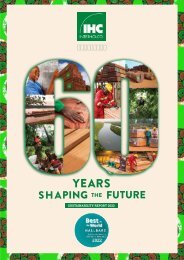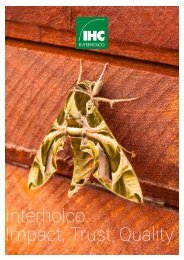Nomenclature Générale des Bois Tropicaux - 7ème édition
(english description below) Cette nomenclature est utilisée pour la mise à jour du 'Harmonized Code System' de l’Organisation Mondiale des Douanes. Dans la circulaire du 5 avril 2005, le Ministère de l’Economie, des Finances et de l’Industrie (France) reconnaît l’ATIBT comme « gardien du temple » de la nomenclature des bois tropicaux. La Commission Européenne mentionne la nomenclature de l’ATIBT comme document de référence pour la mise en œuvre du RBUE. Depuis 1954, l’ATIBT a établi et mis à jour une nomenclature des bois tropicaux faisant correspondre chaque espèce botanique avec un nom pilote reconnu internationalement. La détermination du nom pilote d’une essence est cruciale, car sa commercialisation dépend très largement de l’adoption de ce nom par le public. Le nom pilote assure la protection de l’appellation commerciale de l’essence et l’intégrité des propriétés qui lui sont attribuées, sans risque de confusion. The 1982 version of the general timber nomenclature has finally been updated as some of the 1,750 identified species, are no longer traded, while others, which were not previously included, are now on the market. The present revision has also integrated changes related to new taxonomy, in order to reflect the latest scientific developments. This Nomenclature has been used for the Harmonized Code System, updated by the World Customs Organization. The French Ministry of economy, finance and industry has given official recognition to ATIBT as the reference for the tropical timber nomenclature (NOR: PRMX0508285C of April 5th 2005). The European Commission refers to ATIBT nomenclature as a reference document for the implementation of the EUTR regulation. Since 1954, ATIBT has established and updated a nomenclature of tropical wood, linking each botanical species with an internationally recognized pilot name. A sigle wood species may have many common names; when trading across different countries, this may lead to confusion. Fixing the pilot name of a timber species is crucial, to protect the commercial denomination of the species and guarantee the veracity of the properties linked to that species, without confusion.
(english description below)
Cette nomenclature est utilisée pour la mise à jour du 'Harmonized Code System' de l’Organisation Mondiale des Douanes. Dans la circulaire du 5 avril 2005, le Ministère de l’Economie, des Finances et de l’Industrie (France) reconnaît l’ATIBT comme « gardien du temple » de la nomenclature des bois tropicaux. La Commission Européenne mentionne la nomenclature de l’ATIBT comme document de référence pour la mise en œuvre du RBUE.
Depuis 1954, l’ATIBT a établi et mis à jour une nomenclature des bois tropicaux faisant correspondre chaque espèce botanique avec un nom pilote reconnu internationalement. La détermination du nom pilote d’une essence est cruciale, car sa commercialisation dépend très largement de l’adoption de ce nom par le public. Le nom pilote assure la protection de l’appellation commerciale de l’essence et l’intégrité des propriétés qui lui sont attribuées, sans risque de confusion.
The 1982 version of the general timber nomenclature has finally been updated as some of the 1,750 identified species, are no longer traded, while others, which were not previously included, are now on the market. The present revision has also integrated changes related to new taxonomy, in order to reflect the latest scientific developments.
This Nomenclature has been used for the Harmonized Code System, updated by the World Customs Organization. The French Ministry of economy, finance and industry has given official recognition to ATIBT as the reference for the tropical timber nomenclature (NOR: PRMX0508285C of April 5th 2005). The European Commission refers to ATIBT nomenclature as a reference document for the implementation of the EUTR regulation.
Since 1954, ATIBT has established and updated a nomenclature of tropical wood, linking each botanical species with an internationally recognized pilot name. A sigle wood species may have many common names; when trading across different countries, this may lead to confusion. Fixing the pilot name of a timber species is crucial, to protect the commercial denomination of the species and guarantee the veracity of the properties linked to that species, without confusion.
You also want an ePaper? Increase the reach of your titles
YUMPU automatically turns print PDFs into web optimized ePapers that Google loves.
98 ///
Nomenclature générale des bois tropicaux 2016
NOMS VERNA-
CULAIRES
COMMON
NAMES
PAYS
COUNTRY
NOM PILOTE
PILOT NAME
Bete
GH
Crabwood
d’Afrique
Bété CI Bété
Betis PH Bitis
Beuhago CM Igaganga
Bhoothakkali IN Hard Celtis
Bi CI Eyong
Bibiru BR Greenheart
Bibiru GY Greenheart
Bibolo CM Dibétou
Bidikala CD Aiélé
Bidou CM Ozouga
Bijlhout SR Wallaba
Bilinga GA Bilinga
Billi SL Aiélé
Billian ID Billian
Bilogh-Bi-Nkele GA Akossika
Bilombi CF Etimoé
Bimini SL Landa
Binatoh MY Meranti, Dark Red
Bindang MY Kauri
Bingo CF Ebène d’Afrique
Bintangor MY Bintangor
Bintangur ID Bintangor
Binuang Bini ID Benuang
Binung ID Binung
Bioudou GF Wallaba
Biqui BO Piquiarana
Bissilom GW Acajou Cailcedrat
Bissilom SN Acajou Cailcedrat
Bitehi CI Kanda rose
Bitis MY Bitis
Bitum PG Leban
Black Afara NG Framiré
Black Bean AU Black Bean
Black Ebony IN Ebène noire d’Asie
Black Gum LR Idéwa
Black Kakaralli GY Mata-Mata
Black Kelat MY Kelat
Black Manariballi GY Faveira
Black Olive JM Júcaro
Black Poison US Checham
NOMS VERNA-
CULAIRES
COMMON
NAMES
PAYS
COUNTRY
Black Wattle AU Acacia
Blima-Pu LR Avodiré
NOM PILOTE
PILOT NAME
Bloodhout SR Ucuuba vermelha
Blue Gum AU Gum, Blue
Blue Leaf AU Tasmanian Oak
Bobenkusu CD Bodioa
Bobohufeka MY Kasap
Bobolé CD Mutondo
Boco GF Wamara
Bocote MX Canalete
Bodi rimbo ID Rasamala
Bodioa CI Bodioa
Bodo CI Mambodé
Bodoua CM Ozouga
Bodwe GH Angueuk
Bofelele CD Etimoé
Bofu CI Sobu
Bogdei SL Naga
Bohala CD Afrormosia
Bohele CD Afrormosia
Boiré CI Mambodé
Bois Abeille GF Maçaranduba
Bois caca GF Cupiuba
Bois canelle GF Kaneelhart
Bois canon GF Imbauba
Bois cochon GF Amesclào
Bois cochon GF Balata pomme
Bois de lance GF Lancewood
Bois de Mora GF Macacaúba
Bois de rose femelle GF Bois de rose femelle
Bois d’encens GF Almàcigo
Bois d’encens GF Umiri
Bois d’orange TT Moral
Bois du diable GF Açacu
Bois Flot TT Balsa
Bois fourmi GF Formigueiro
Bois Gri-Gri HT Júcaro
Bois jaune GF Tatajuba
Bois Margot GF Júcaro
Bois mulâtre GF Kroebara
Bois pagode GF Inga
Bois perdrix GF Panacoco














